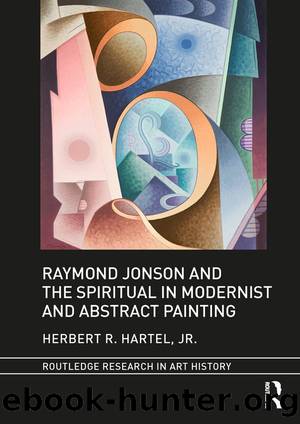Raymond Jonson and the Spiritual in Modernist and Abstract Painting by Herbert R. Hartel Jr

Author:Herbert R. Hartel, Jr.
Language: eng
Format: epub
Publisher: Taylor & Francis Ltd
Published: 2018-02-13T00:00:00+00:00
The common denominator in achieving dissonant relationships, according to Jonson, is that two areas or shapes of color must be adjacent; they must touch one another. He also felt that the overall arrangement of lines, shapes, and forms is inextricably tied to dissonant color effects.
Jonson’s earliest forays into abstraction were hesitant and erratic. There survives a small drawing in black ink from 1921 that is probably his first attempt to work in Kandinsky’s early abstract style of 1909 to 1914. It is reminiscent of the illustrations in Concerning the Spiritual in Art, which Jonson read at this time, and appears to have been a quick attempt to emulate Kandinsky’s style and follow his advice and theories. In the middle of1929, he created Space Abstraction (a Construction), a totally abstract, painted relief-assemblage.25 This vividly colored, mixed-media composition was done with oil on wood panel and intricately cut Masonite and wooden boards affixed to the flat panel. The use of such non-traditional media was highly experimental for Jonson, who found it unsuccessful because he quickly abandoned it, perhaps having concluded that it failed to conjure the spiritual in any significant way.26 By 1929, there were many possible precedents for mixed-media assemblages that could have influenced this work, including Cubist collage, Dada readymades, collages, and assemblages, and Constructivist sculpture and assemblages. Stylistically, Space Abstraction is closest to the sculptural paintings of Jean Arp and the relief assemblages of Kurt Schwitters, but it remains unknown how familiar Jonson was with developments in Dada sculpture.
Jonson’s first totally abstract painting is Variation I, which was done in late 1929.27 This work is part of a vaguely conceived series of three small oil paintings done in 1929, 1930, and 1932 that were intended as tokens of affection and possibly birthday gifts for Arthur and May.28 Whereas Variation II suggests plant forms and Variation III is a highly abstracted, sketchy Southwestern landscape, Variation I is completely non-representational. It is the first known surviving painting by Jonson to show the direct stylistic influence of Kandinsky, particularly that of his highly geometric Bauhaus-era paintings, such as In Blue of 1925. Variation I is only 6” x 6” and consists of numerous yellow and blue-violet circles and rectangles, some of them solid and clearly defined while others are translucent and diaphanous, and small groups of intersecting lines with colors filled into some of the intersections, floating in a deep ultramarine space. The pattern of colored diamonds outlined in black is similar to the description of the dress in Symphonic Portrait of May van Dyke. The ultimate effect of this painting is that of bubbles popping and floating and colored planes shifting and intersecting.29 Jonson probably experimented with pure abstraction on such a small scale because he was still very uncertain about his mastery of its possibilities.
Southwest Arrangement [see Figure 4.1], an intriguing oil on canvas of 1933, is an unusual painting for Jonson because it is one of only a few that he did that reflects the influence of Native American art on his developing abstract sensibilities.
Download
This site does not store any files on its server. We only index and link to content provided by other sites. Please contact the content providers to delete copyright contents if any and email us, we'll remove relevant links or contents immediately.
The Secret History by Donna Tartt(18157)
Red Sparrow by Jason Matthews(5195)
Harry Potter 02 & The Chamber Of Secrets (Illustrated) by J.K. Rowling(3555)
In a Sunburned Country by Bill Bryson(3364)
Drawing Cutting Edge Anatomy by Christopher Hart(3290)
Figure Drawing for Artists by Steve Huston(3267)
Harry Potter and the Prisoner of Azkaban (Book 3) by J. K. Rowling(3108)
The Daily Stoic by Holiday Ryan & Hanselman Stephen(3107)
Japanese Design by Patricia J. Graham(2997)
The Roots of Romanticism (Second Edition) by Berlin Isaiah Hardy Henry Gray John(2819)
Make Comics Like the Pros by Greg Pak(2757)
Stacked Decks by The Rotenberg Collection(2685)
Harry Potter and the Deathly Hallows (7) by J.K. Rowling(2549)
Draw-A-Saurus by James Silvani(2501)
Tattoo Art by Doralba Picerno(2484)
On Photography by Susan Sontag(2481)
Foreign Devils on the Silk Road: The Search for the Lost Treasures of Central Asia by Peter Hopkirk(2385)
Churchill by Paul Johnson(2360)
The Daily Stoic by Ryan Holiday & Stephen Hanselman(2341)
